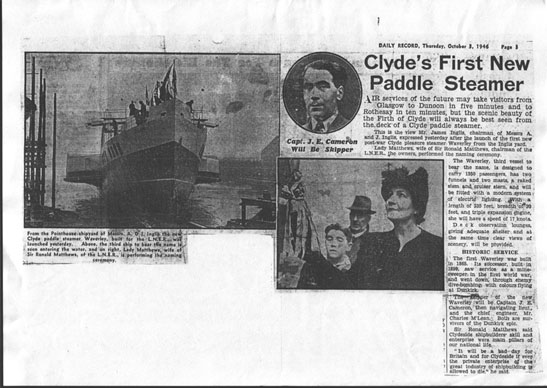
60th Anniversary of Launch
A commemorative note by Iain Quinn

The order from the London & North Eastern Railway (LNER) Shipping Division in London came to A&J Inglis Pointhouse Shipyard in the River Kelvin in November 1945 with the keel laid in December.
A&J Inglis had a long standing tradition of building ships for this company and
its predecessors, a total of 12 over the years, all with the same funnel colours
as Waverley's current livery.
Waverley was launched during the afternoon on a rainy 2nd October 1946. A&J
Inglis's yard manager at the time was James Inglis, son of Dr John Inglis, one
of the co-founders of the company with his brother Antony. The paddler was
designed by William McGregor, senior in this field at Inglis, assisted by James
Grub, Design Draughtsman who undertook a lot of the detailed work.
Following the launch, the steamer was taken to the fitting out wharf by late
afternoon. Tugs from the Clyde Shipping Co attended, as they did for every
Inglis launch.
The dignitaries retired to the City Chambers in George Square for speeches and a
meal. Lady Matthews, wife of Sir Ronald (Chairman of the LNER), launched the
steamer and Sir Ronald spoke at the dinner about the new ship's role, being the
first ship built for the LNER since World War 2. What he could not know then was
that she actually turned out to be the last ever built of its type and
eventually attained world fame as the last sea-going paddle steamer in the
world.
Also present on 2 October was her first Captain, John Cameron DSC RNR who
oversaw the build at Inglis following his release from the Admiralty. Captain
Cameron had been in command of HMS Waverley, the peace-time PS Waverley which
had been launched at Inglis in 29 May 1899, when she was lost in action on her
way back from Dunkirk on 29 May 1940. He received his decoration from King
George VI in 1946. He revisited the French shore aboard the present Waverley in
1980 to lay a wreath in memory of his fallen comrades.
The fitting out of the new steamer continued over the ensuing months from
January to March 1947, while Glasgow experienced sub-zero temperatures. During
the spring of 1947, Waverley was at Greenock for her Main Engine to be fitted.
The machinery was constructed during 1946 at the Rankin & Blackmore Eagle
Foundry in that town, engine no 520, and one of the last largest ever fitted to
a Clyde paddle steamer.
A&J Inglis continued to build and repair ships until 1962 when they ceased
trading. Waverley returned every year for her annual refit until closure. The
yard is long-since overgrown and is now to be the site for Glasgow's new
Transport Museum, which will replace the one at Kelvin Hall.
60 years later, Waverley will steam passed the site of her launch on her
commemorative cruises from Glasgow on 14 & 15 October 2006.
Her maiden voyage took place on 16 June 1947 from Craigendoran to Lochgoihead
and Arrochar. The present writer is hoping WSN will commemorate her Diamond
Jubilee in 2007 on that day.